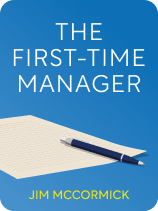

This article is an excerpt from the Shortform book guide to "The First-Time Manager" by Jim McCormick. Shortform has the world's best summaries and analyses of books you should be reading.
Like this article? Sign up for a free trial here.
Are you having trouble building trust with your employees? Should you get to know your employees more?
In The First-Time Manager, Jim McCormick writes that a way to transition smoothly into your new management role is to build relationships with your employees. This makes people feel valued and helps you understand how to best support them.
Let’s look at how to build relationships with employees to make you feel comfortable in your new role.
Start Building Relationships With Your Employees
To learn how to build relationships with employees, McCormick recommends you start by meeting with each employee individually within the first 60 days. Focus on establishing a personal connection and communicate that you care about them individually and are there to support them. Lay out expectations for how you want to communicate with them—for instance, that you want them to share their goals, give feedback, and be open about their challenges.
(Shortform note: Building relationships with employees is one key component to leading with radical candor—a way of managing people that focuses on truly caring about your employees. In Radical Candor, Kim Scott says you can lead with this mindset by understanding and respecting your employees’ whole selves. When you meet with each employee, invite them to share things about their personal lives but respect their boundaries. When you show you care personally about your employees, they bring their best selves to work and achieve better results.)
After your first meeting, continue to have weekly one-on-one meetings with each employee. This not only helps you get to know them better, but it’s also a more efficient way of addressing any concerns they may have. Rather than having to vie for your attention or interrupt your work, employees can reserve the topics they want to discuss for their regular meeting with you.
(Shortform note: While McCormick recommends holding weekly one-on-one meetings, he doesn’t specify how to best conduct them. In The Hard Thing About Hard Things, Ben Horowitz explains that one-on-ones are private, relatively informal meetings that you can use to discover problems and build on ideas. To run effective one-on-one meetings, let your employee drive: Let them set the agenda and encourage them to do 90% of the talking by asking open-ended questions.)
Communicate With Honesty and Transparency
A key element of building relationships with your employees and earning their trust and confidence is practicing honest and open communication.
(Shortform note: Although honest and open communication is highly valued by employees and executives, it’s lacking in many workplaces. In one study, less than 50% of respondents felt they worked in an environment in which people could talk about issues effectively and honestly, but nearly 100% said this type of environment was important to them.)
McCormick provides a few tips for communicating with honesty and transparency:
Tip #1: Admit what you don’t know. Many managers think they have to know everything or they’ll be judged negatively by their employees. But McCormick says you should admit when you don’t have the answers—doing so establishes trust. If you lie about what you know, you lose credibility and respect.
(Shortform note: Other experts agree with McCormick and give tips for how to respond when you don’t know the answer: First, verify your understanding of the question. Then, if you still don’t know the answer, be honest, tell them you’ll need to do research, and give a date when you’ll follow up with them. This makes you seem human and relatable yet also assures people that you’re doing what you can to meet their needs.)
Tip #2: Share what you do know. A good manager readily shares information with their employees instead of withholding it from them. If you leave your team in the dark, especially about matters that concern them, you’ll only spark rumors and spread inaccurate information.
(Shortform note: Some experts caution against sharing too much information with your employees, as this could cause people to become distracted or overwhelmed. Instead, they recommend you find a middle ground: Give them the facts they need to succeed in their tasks and have an open door policy where your employees can ask any questions they might have.)
Tip #3: Practice active listening. To come across as engaged in a conversation so that the other person feels heard, adopt encouraging body language, make supportive statements, ask questions, and restate what the other person said. Active listening helps your employees feel valued and encourages them to speak up.
(Shortform note: When practicing McCormick’s active listening techniques, be sure you genuinely care about what the other person’s saying. In The Energy Bus, Jon Gordon says you need to show empathy for the other person to feel heard, not just give off active listening cues. In Time to Think, Nancy Kline advises specifically against restating what the other person said. Restating people’s words gives the impression you weren’t listening well enough to remember them. Instead, she recommends you simply remain quiet and give them as much time as they need to say everything they want to say. This allows them to unravel and express everything on their mind.

———End of Preview———
Like what you just read? Read the rest of the world's best book summary and analysis of Jim McCormick's "The First-Time Manager" at Shortform.
Here's what you'll find in our full The First-Time Manager summary:
- How to succeed as a manager, whether it's your first time or not
- Why managers should shift their focus from tasks to people
- How to gain the trust of your employees and empower them to take initiative






